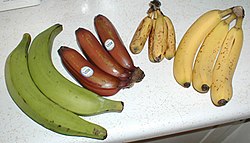The total number of cultivars of bananas and plantains has been estimated to be anything from around 300 to more than 1000. Names are highly confused, even within a single country. Many common names do not refer to a single cultivar or clone; for example 'Lady's Finger' or 'Lady Finger' has been used as the name for members of different genome groups, including AA and AAB. Many other names are synonyms of cultivars grown in the same or different countries.[9] Attempts have been made to create lists of synonyms. In 2000, Valmayor et al. listed equivalent local names for 68 cultivars across five Southeast Asian countries (the Philippines, Malaysia, Indonesia, Thailand and Vietnam), together with their internationally used names. They considered a further 81 cultivars to be unique to one country.[1] In 2007, Ploetz et al. listed more cultivar names and synonyms, with an emphasis on those grown in the islands of the Pacific, but including some grown in areas such as India, Africa and South America. As an example, for the widely grown cultivar 'Dwarf Cavendish', they gave 58 synonyms from 29 different countries or geographical areas.[9] ProMusa has created a checklist of banana cultivar names based on available literature.[10]
A recent development is the use of "somaclones" in banana cultivation. Micropropagation involves growing plants from very small amounts of source tissue, sometimes even a single cell, under sterile conditions using artificial techniques to induce growth. The purpose of micropropagation is often to produce a large number of genetically identical offspring. However, by inducing mutations through various means, it is possible to produce plants which differ slightly from the "parent" plant and from each other ("somaclonal variations"). By growing on these somaclones and selecting those with desirable features, new cultivars can be produced which are very similar to an existing cultivar, but differ in one or two features, such as disease resistance. Somaclones may only be distinguishable bygenetic analysis.[11]
AA Group[edit]
Diploid Musa acuminata, both wild banana plants and cultivars
- Chingan banana
- Lacatan banana
- Lady Finger banana (Sugar banana)
- Pisang jari buaya (Crocodile fingers banana)
- Señorita banana (Monkoy, Arnibal banana, Cuarenta dias, Cariñosa, Pisang Empat Puluh Hari, Pisang Lampung)[12]
- Sinwobogi banana
